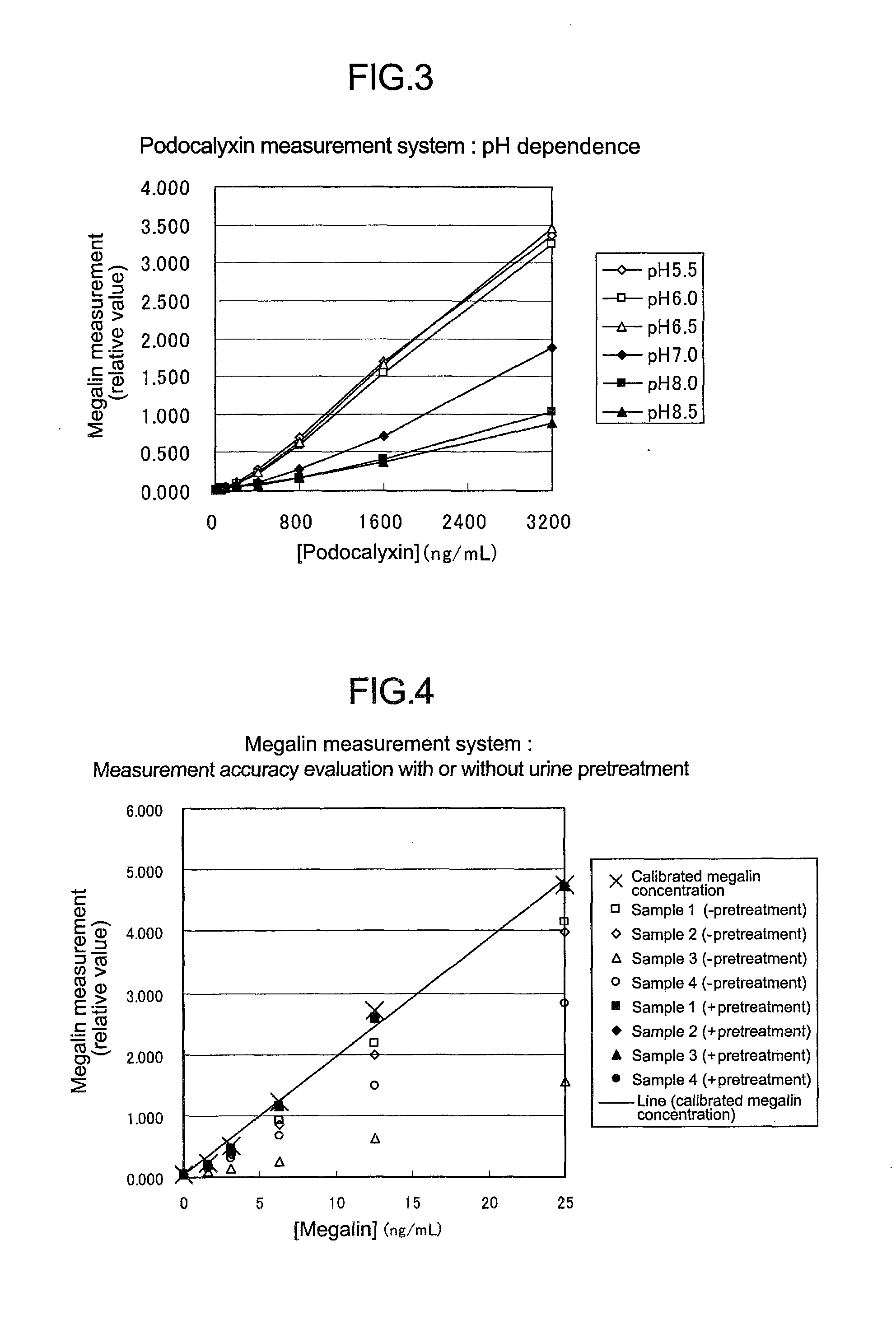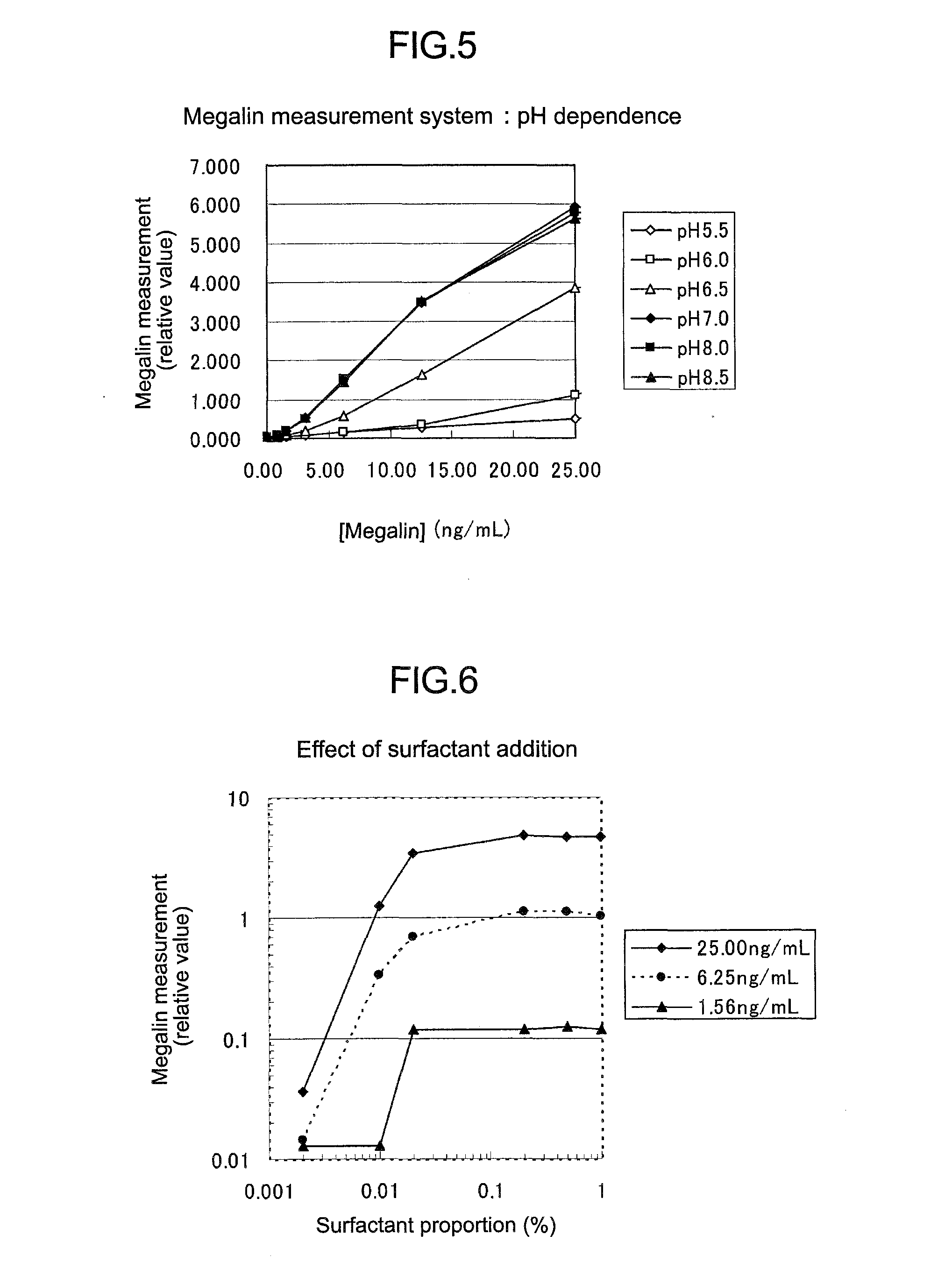Urine pretreatment agent for urinary protein quantitation, urine pretreatment method, and urinary protein quantitation method
a technology of urine pretreatment and urine protein, which is applied in the direction of instruments, chemical methods analysis, material analysis, etc., can solve the problems of podocalyxin content, inability to quantitate a trace amount, and inability to accurately analyze urine samples, etc., to achieve efficient compensation and homogenization of urine ph, prevent ph variations, and large buffer capacity
- Summary
- Abstract
- Description
- Claims
- Application Information
AI Technical Summary
Benefits of technology
Problems solved by technology
Method used
Image
Examples
example 1
Evaluation Method
(1) Urine Pretreatment Agent and Preparation of Urine Pretreatment Agent
[0095]7.4 g of chelating agent (EDTA), 10.7 g of surfactant (Triton X-100), and a buffer listed in Table 1 were mixed to make a urine pretreatment agent, and the urine pretreatment agent was mixed with water to make 100 mL of urine pretreatment solution.
(2) Pretreatment of Urine Sample
[0096]90 parts by mass of a urine sample was mixed with 10 parts by mass of a urine pretreatment solution, which had been prepared in accordance with the formula in Table 1, and then the pH value of the sample was measured with a pH meter. The urine pH was measured using a compact pH meter (Twin pH) manufactured by Horiba, Ltd.
(Results)
[0097]Table 1 lists the maximum, minimum, and average pH, and the standard deviation of the 80 samples measured by the above method, and FIG. 1 shows a graph prepared by plotting the standard deviation of the 80 samples against the buffer concentration.
TABLE 1BufferSam-concen-pH valu...
example 2
[0099]The aim of Example 2 is to apply a urine sample pretreatment solution composition and a urine sample pretreatment method using the same to a human urinary podocalyxin detection system using ELISA method.
(Method)
(1) Production of Anti-Human Podocalyxin Mouse Monoclonal Antibody
[0100]50 μg of human podocalyxin was injected into mouse peritoneum several times together with an adjuvant, and the increase in serum titer was confirmed. Three days after intravenous booster injection, the spleen was taken out, and the spleen cells thus obtained and the mouse myeloma cells were fused in the proportions of 10:1 in terms of the cell count in the presence of polyethylene glycol 3500, thus producing hybridoma cells.
[0101]The hybridoma cells were cultured in a 5% CO2 atmosphere at 37° C. for 1 week, and the presence or absence of the anti-human podocalyxin antibody in the culture supernatant was examined. Hybridoma cells in positive wells which exhibited antibody production were diluted by a...
example 3
[0115]The aim of Example 3 is to evaluate the pH-dependent reactivity of the human urinary podocalyxin detection system using ELISA method.
[0116]The urinary podocalyxin measurement system established in Example 2 was evaluated for its pH-dependent reactivity. In order to evaluate the pH dependence, in place of urine samples, pH reactivity test solutions were prepared, the solutions containing different six buffer solutions having different pH values composed of 50 mM MES-NaOH (pH 5.5, 6.0, 6.5, or 7.0) or 50 mM Tris-HCl (pH 8.0 or 8.5), and 0.2% (v. / v.) Triton X-100, and 20 mM EDTA. A pH reactivity test solution spiked with a human podocalyxin antigen was used in place of a urine sample, and tested for the pH dependence in the urinary megalin measurement system.
TABLE 3[Podocalyxin]pH 5.5pH 6.0pH 6.5pH 7.0pH 8.0pH 8.5Remarks(ng / mL)O.D.(450 nm-630 nm)Podocalyxinmeasurement(relative value)32003.3683.2453.4491.8721.0270.874Example16001.6841.5411.6600.7110.4100.370Example8000.6900.5970.6...
PUM
| Property | Measurement | Unit |
|---|---|---|
| pH | aaaaa | aaaaa |
| mass | aaaaa | aaaaa |
| concentration | aaaaa | aaaaa |
Abstract
Description
Claims
Application Information
 Login to View More
Login to View More - R&D
- Intellectual Property
- Life Sciences
- Materials
- Tech Scout
- Unparalleled Data Quality
- Higher Quality Content
- 60% Fewer Hallucinations
Browse by: Latest US Patents, China's latest patents, Technical Efficacy Thesaurus, Application Domain, Technology Topic, Popular Technical Reports.
© 2025 PatSnap. All rights reserved.Legal|Privacy policy|Modern Slavery Act Transparency Statement|Sitemap|About US| Contact US: help@patsnap.com



